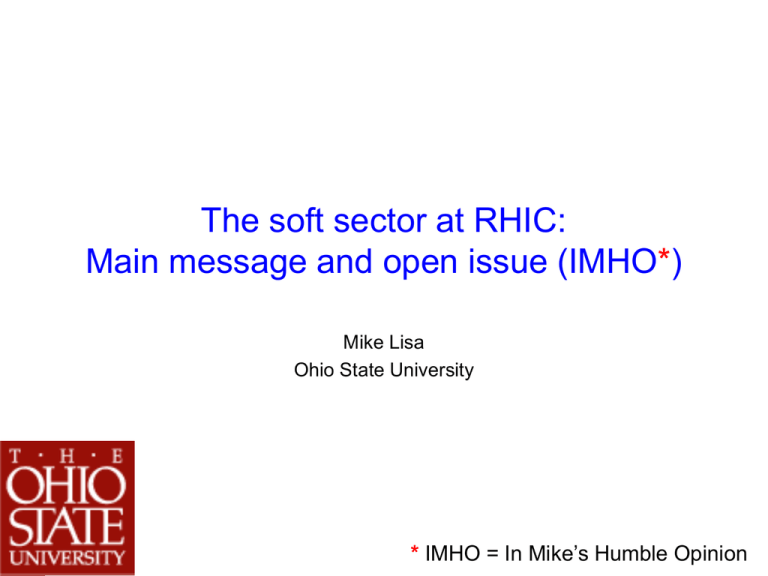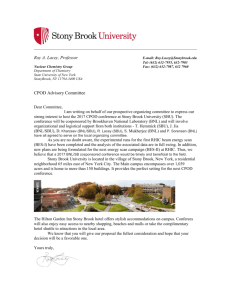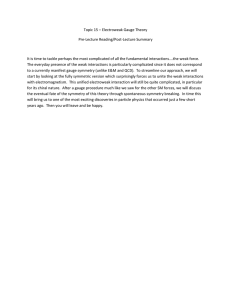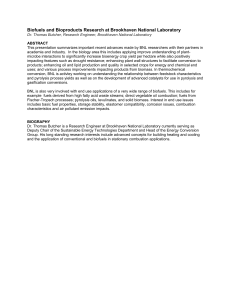The soft sector at RHIC: Main message and open issue (IMHO ) *
advertisement

The soft sector at RHIC: Main message and open issue (IMHO*) Mike Lisa Ohio State University * IMHO = In Mike’s Humble Opinion Outline • Importance of the soft sector / geometry • flow & hydrodynamics - dynamical connection to EoS • space & momentum probes - proof / characterization of system • evolution of the soft sector & multiplicity dependence • an important open issue 10 May 2006 Strong & Electroweak Matter (SEWM06) - BNL 2 R.H.I.C. defined... • collision of nuclei sufficiently large that nuclear details unimportant – distinct from nuclear or particle physics – “Geranium on Linoleum” • sufficiently large for meaningful bulk & thermodynamic quantities • non-trivial spatial scales & geometry drive bulk dynamics (e.g. flow) • how big is “sufficient” ? – important reference issue 10 May 2006 Strong & Electroweak Matter (SEWM06) - BNL 3 phase structure of bulk system: • driving symmetries • long-range collective behaviour • “new” physics [superfluidity in l-He] • relevance of meaningful EoS 10 May 2006 Strong & Electroweak Matter (SEWM06) - BNL 4 Why care about the soft sector (the “brown muck”)? • Well-justified excitement about high-pT physics 99.5% • But to study a new type of matter... bulk system • large-scale, non-perturbative (soft) deconfinement • jets/ect are probes of this system • Crucial to understand bulk properties/dynamics in their own right matter of interest 10 May 2006 hard probes Strong & Electroweak Matter (SEWM06) - BNL 5 Chemistry: liquid-gas PT liquid-gas phase PT “caloric curve” Pochodzalla et al, PRL 75 1040 (1995) • previous experience at lower energies (also: critical exponents) • “comforting” plot (though not as simple as it may appear) • l (liquid) or gaseous (g) phase may be measured in exit channel l-g PT observation/characterization easier than h-p PT 10 May 2006 Strong & Electroweak Matter (SEWM06) - BNL 6 Chemistry: hadron-parton PT p2 i ~ g i dp p 2 m 2 1 exp T i i • thermochemical fit works well • Tassymtote ~ Tcrit from Lattice (@ b=0) • nature of this beast: “exciting” features require theoretical imagination 10 May 2006 Strong & Electroweak Matter (SEWM06) - BNL 7 Beyond Chemistry: a dynamical connection bulk (soft sector) collective flow 10 May 2006 Strong & Electroweak Matter (SEWM06) - BNL 8 Hydrodynamics: the high-density limit • local thermal equilibrium* • solve equations for fluid elements (not particles): – continuity – conservation laws characteristic global spacemomentum correlation pattern – Equation of State (EoS) • lower energy collisions – works qualitatively – overpredicts collective effects – RHIC is first time hydro works! * how? Strickland...Strong & Electroweak Matter (SEWM06) - BNL 10 MayMrowczynski, 2006 beware such statements... lattice QCD input 9 Microexplosions Femtoexplosions • energy quickly deposited s 0.1 J 1 J • enter plasma phase 17 J/m3 • expand10 5 GeV/fm3 = 1036 J/m3 hydrodynamically to6 original phase200 MeV = 1012 K T• cool back10 K • do geometric “postmortem” & infer momentum rate 1018 K/sec 1035 K/s 10 May 2006 Strong & Electroweak Matter (SEWM06) - BNL 10 The Geometry connection: Momentum is clear (even if experimentally challenging). How to access geometry? 10 May 2006 Strong & Electroweak Matter (SEWM06) - BNL 11 Impact parameter & Reaction plane Impact parameter vector b : beam direction connects centers of colliding nuclei b = 0 “central collision” many particles produced “peripheral collision” fewer particles produced b 10 May 2006 Strong & Electroweak Matter (SEWM06) - BNL 12 Impact parameter & Reaction plane Impact parameter vector b : beam direction connects centers of colliding nuclei Reaction plane: spanned by beam direction and b b = 0 “central collision” many particles produced “peripheral collision” fewer particles produced b 10 May 2006 b Strong & Electroweak Matter (SEWM06) - BNL 13 How do semi-central collisions evolve? 1) Superposition of independent p+p: momenta pointed at random relative to reaction plane b 10 May 2006 Strong & Electroweak Matter (SEWM06) - BNL 14 How do semi-central collisions evolve? 1) Superposition of independent p+p: high density / pressure at center momenta pointed at random relative to reaction plane 2) Evolution as a bulk system Pressure gradients (larger in-plane) push bulk “out” “flow” “zero” pressure in surrounding vacuum more, faster particles seen in-plane b 10 May 2006 Strong & Electroweak Matter (SEWM06) - BNL 15 How do semi-central collisions evolve? 1) Superposition of independent p+p: N momenta pointed at random relative to reaction plane 0 /4 /2 0 /4 /2 3/4 3/4 -RP (rad) 2) Evolution as a bulk system Pressure gradients (larger in-plane) push bulk “out” “flow” more, faster particles seen in-plane 10 May 2006 N Strong & Electroweak Matter (SEWM06) - BNL -RP (rad) 16 Azimuthal distributions at RHIC STAR, PRL90 032301 (2003) b ≈ 6.5 fm b ≈ 4 fm “central” collisions midcentral collisions 10 May 2006 Strong & Electroweak Matter (SEWM06) - BNL 17 Azimuthal distributions at RHIC STAR, PRL90 032301 (2003) b ≈ 10 fm b ≈ 6.5 fm b ≈ 4 fm peripheral collisions 10 May 2006 Strong & Electroweak Matter (SEWM06) - BNL 18 Elliptic flow – collectivity & sensitivity to early system “Elliptic flow” v2 STAR, PRL90 032301 (2003) • collective motion “v2” • geometrical anisotropy momentum anisotropy • sensitive to early pressure and thermalization • characteristic mass ordering • sensitive to EoS STAR (20-60% centrality) hydro:Huovinen et al (2001) • “QGP” PT preferred (?) Hydrodynamic calculation of system evolution 10 May 2006 Strong & Electroweak Matter (SEWM06) - BNL 19 Trends, soft sector, and RHI history A. Wetzler (2005) Finally, we understand it! Just one event! M Gyulassy ‘95 10 May 2006 Then: p-dependent potentials, surface effects, hard-cores, absoption... Strong & Electroweak Matter (SEWM06) - BNL 20 R.H.I. History - beware single-point agreement STAR, PRL86 402 (2001) 10 May 2006 Strong & Electroweak Matter (SEWM06) - BNL 21 v2: demands 1st-order PT [or something like it]? • sensitive to EoS, esp. heavy particles • but only (non-realistic) strong 1st-order P.T. needed to fit data? • “Lattice” fits as poorly as “pure hadronic” EoS • Detailed agreement between ideal hydro and measured v2(mass,pt) an accident? (Hirano and Gyulassy arXiv:nucl-th/0506049) H: pure hadronic qp: “lattice” Q: 1st order [“standard”] T: “1st order” + slow approach to SB limit 10 May 2006 Huovinen, Strong & Electroweak Matter (SEWM06) - P. BNL NP A761 296 (2005) 22 Geometrical consequences of flow: femtoscopy (“HBT”) C2(Qinv) separation distribution from momentum correlations pa xa xb STAR preliminary pa pb xa xb p+p R ~ 1 fm R~1/QCORR 10 May 2006 pb Au+Au R ~ 6 fm Strong & Electroweak Matter (SEWM06) - BNL Qinv (GeV/c) 23 Geometric substructure? random (non-)system: all observers measure the “whole source” 10 May 2006 Strong & Electroweak Matter (SEWM06) - BNL 24 Flow-generated substructure random (non-)system: all observers measure the “whole source” Specific predictions of bulk collective flow: • space-momentum (x-p) correlations • faster (high pT) particles come from •smaller source •closer to “the edge” 10 May 2006 Strong & Electroweak Matter (SEWM06) - BNL 25 Flow-dominated “Blast-wave” model PRC70 044907 (2004) R (fm) Spectra v2 HBT STAR PRL 91 262301 (2003) K mT (GeV/c) space-momentum substructure mapped in detail 10 May 2006 Strong & Electroweak Matter (SEWM06) - BNL 26 Prejudices: Winter Workshop, 1999 10 May 2006 Strong & Electroweak Matter (SEWM06) - BNL 27 Paradigm shift • many did not anticipate what turned out to be THE story of the bulk – “RHIC will be different than anything seen before” – keep an open mind Harris & Mueller AnnRevNuclPartSci ‘96 P. Kolb, J. Sollfrank, and U. Heinz, Phys. Rev. C. C62 054909 (2000). 10 May 2006 Strong & Electroweak Matter (SEWM06) - BNL 28 Paradigm shift • many did not anticipate what turned out to be THE story of the bulk – “RHIC will be different than anything seen before” – keep an open mind • instead: “evolution rather than revolution” (the story of R.H.I.C.) ARNPS 55 357 (2005) 10 May 2006 Strong & Electroweak Matter (SEWM06) - BNL Lisa, Winter Wkshp ‘99 29 What drives the soft sector ? H. Caines (STAR) QM05 NA57 (open) STAR (filled) LPSW nucl-ex/0505014 10 May 2006 NA57 (open) STAR (filled) S. Manly (PHOBOS) QM05 Strong & Electroweak Matter (SEWM06) - BNL 30 Paradigm shift • many did not anticipate what turned out to be THE story of the bulk – keep an open mind • instead: “evolution rather than revolution” (the story of R.H.I.C.) • “everything” scales only with multiplicity (indep A,B, s...)?! – low-energy central collision ~ high-energy peripheral collision – entropy is driving factor (more hydro-dominance)? 10 May 2006 Strong & Electroweak Matter (SEWM06) - BNL 31 Paradigm shift • many did not anticipate what turned out to be THE story of the bulk – keep an open mind • instead: “evolution rather than revolution” (the story of R.H.I.C.) • “everything” scales only with multiplicity (indep A,B, s...)?! – low-energy central collision ~ high-energy peripheral collision – entropy is driving factor (more hydro-dominance)? • next logical step... – again (like low s case) : is RHIC so different from pp ? bulk behaviour? – again, keep an open mind p+p, 7 May 2006 10 May 2006 Au+Au 2002 Strong & Electroweak Matter (SEWM06) - BNL 32 pp = “a small AA” ? ; Is geometry meaningful? Collectivity is meaningless without geometry Energy loss of energetic partons in quark-gluon plasma: Possible extinction of high pT jets in hadron-hadron collisions J.D. Bjorken, 1982 p+p, 7 May 2006 10 May 2006 Au+Au 2002 Strong & Electroweak Matter (SEWM06) - BNL 33 D. Kharzeev Transverse Dynamics Workshop March 2003 sure, but how would we know? • theoretical prejudice • experimental signatures 10 May 2006 Strong & Electroweak Matter (SEWM06) - BNL 34 Zbigniew Chajecki QM05 R Z(fm) 1. Heisenberg uncertainty? Z0 decay @ LEP •2.e.g. G. fragmentation? Alexander String (Lund) ••3.“plausible” ineffects? z-direction pResonance maybe (??) T dependence •• unlikely in transvrseprobably no dependence • mass e.g. Wiedemann & DELPHI Heinz ‘97 [Andersson, Moriond 2000] • maybe, but presumably different effect significantly femtoscopy in p+p @ RHIC p+p and A+A measured in same experiment • unique opportunity to compare physics • what causes pT-dependence in p+p? • same cause as in A+A? than for Au+Au R (fm) • under investigation K p STAR preliminary hep-ph/0108194 10 May 2006 m, mT (GeV) mT (GeV) Strong & Electroweak Matter (SEWM06) - BNL mT (GeV) 35 Zbigniew Chajecki QM05 3. Resonance effects? 4. Bulk system („hydro”) in pp? DELPHI flow not expected in such a small system as p+p R (fm) e.g. Shuryak: hep-ph/0405066 Csorgo et al.: K Buda-Lund treatment of p+p collision as d+Au : Rlong doesn’t change bulk system with centrality p (w/ temperature gradients) hep-ph/0406042 femtoscopy in p+p @ RHIC p+p and A+A measured in same experiment • unique opportunity to compare physics • what causes pT-dependence in p+p? in A+A? • same cause as 1/(2mT)d2n/(dmTdy) R Z(fm) 1. Heisenberg uncertainty? Z0 decay @ LEP 2. String fragmentation? (Lund) K p mT-m (GeV) RSIDE ROUT RLONG STAR preliminary hep-ph/0108194 10 May 2006 m, mT (GeV) mT (GeV) Strong & Electroweak Matter (SEWM06) - BNL mT (GeV) mT (GeV) 36 Surprising („puzzling”) scaling Ratio of (AuAu, CuCu, dAu) HBT radii by pp All pT(mT) dependences of HBT radii observed by STAR scale with pp although it’s expected that different origins drive these dependences HBT radii scale with pp Scary coincidence or something deeper? pp, dAu, CuCu - STAR preliminary 10 May 2006 Strong & Electroweak Matter (SEWM06) - BNL 37 Other soft “resembles data” v2 Is the physics similar? Is the data trying to tell us something? PYTHIA 6.4 Minbias (Single nondiffractive) p+p @ 200 GeV N.B.: Pythia mocks up the soft sector Cannot, itself, (dis)prove flow/non-flow What can we tell from the data? 10 May 2006 Strong & Electroweak Matter (SEWM06) - BNL 38 Summary (1/2) • Importance of the soft sector • elliptic flow: – sensitive to high-density (early) aspects of EoS – hydro works •experimental basis of the big story (“perfect liquid”) in soft sector •single-point agreement : common in our field, and worrysome – unique connection to underlying physics under construction (likely to require details a la nuclear EoS) • flow mapped in detail through space-momentum substructure • no doubt: AA ≠ N*(p+p) 10 May 2006 Strong & Electroweak Matter (SEWM06) - BNL 39 Summary (2/2) • evolution (not revolution) of soft sector • multiplicity (entropy?) dominance • pp = “little AA” ?? – besides the idea that “it shouldn’t be”, what points against it? – is “matter” created in such a small system? – baryon/meson splitting in v2, etc... – “universality”: route to deep physical insight, or cruel joke? • IMHO, this is the most important open issue in the bulk sector - do we know our “reference”? – deserves much more attention – RHIC (& LHC) programs might make unique contributions to particle and HI physics here 10 May 2006 Strong & Electroweak Matter (SEWM06) - BNL 40 The End Flow-dominated “Blast-wave” model PRC70 044907 (2004) R (fm) Spectra v2 HBT STAR PRL 91 262301 (2003) K mT (GeV/c) space-momentum substructure mapped in detail 10 May 2006 Strong & Electroweak Matter (SEWM06) - BNL 42 here i am • now say: • flow is established (hope you are convinced!) • flow is important (IF it agrees with hydro, then basis of perfect fluid statement) • but... flow was not universally accepted. – even though ALL (ALL!) other HIC showed flow, there was the idea that “RHIC physics will be different” – well, it is, but only quantitatively – but OK data showed different so now we know better • now something harder: – we all assume “A+A *must* be different than p+p” – really? • mult scaling • HBT(pT) • Dima/Bjorken • keep an open mind! This field IS full of surprises, but they lie in the detailed systematics, NOT in sharp “differences”! 10 May 2006 Strong & Electroweak Matter (SEWM06) - BNL 43 Raimond’s Summary of HIF 2005 • Elliptic flow is a very powerful observable – Its magnitude in agreement with prediction from ideal hydrodynamics and ideal hydro + hadron cascade – Mass dependence of elliptic flow in agreement with common collective velocity and favors soft effective EOS • The basis of the ideal fluid statement • The break down of hydro behavior at more peripheral collisions higher transverse momenta and away from midrapidity can be understood and was qualitatively predicted in hydro+hadron cascade calculations (Teany and Shuryak) • However, the observed monotonic behavior provides not very satisfying proof, like to see at least some change in slope of energy dependence v2/ (slope of v2(pt) perhaps more sensitive?) • What about v4? • Still a lot to do and understand (both at RHIC and at the LHC) 10 May 2006 Strong & Electroweak Matter (SEWM06) - BNL 44 • so, flow is the big story of the soft sector – other consequences? – spectra (BW fits, basically): more massive particles pushed more - no time – space-time • after all, geometry is the whole key to this game, right? • what would nonflowing versus flowing system do? [use hydro Kolb scenario versus pp superposition] • femtoscopy (HBT and pi-K) can distinguish : QUANTITATIVE agreement – definitely definitely definitely collective, bulk flow in AA - it is “big enough” • note: before RHIC turn-on, many folks did not expect flow: “RHIC will be so different” – show Zajc slide from 99 workshop – show flow excitation functions - we shoulda thought (Yogi Bera) – point: many things are similar to “reference” - systematics counts! • similarly, let us keep an open mind: is SOFT SECTOR p+p REALLY... – understood? – so different? • MULT SCALING: (incl strange) - and LHC “prediction”... • No time for – BW fits to spectra multiplicity scaling 10– May 2006 Strong & Electroweak Matter (SEWM06) - BNL 45 Outline • • • • • • What drives the soft sector @ RHIC (and where is it driving us)? soft sector is over”flow”ing with systematics (i.e. bulk signatures are “the story”) dN/d\eta is god p+p-->A+A “evolution not revolution” pp @ high roots ~ AA @ low roots (mult) at least in soft sector is this a “new” puzzle (puzzle in soft sector, that is. No need to view it as HBT puzzle per se) • What argues against saying that pp = “little AA” (with flow and e-thing)? – BULK measurement HBT (and non-id)? NO – BULK measurement v2 (NO) – BULK measurement spectra (NO) – strangeness enhancement NO (b/c seems smooth with mult. “enhancement is DEFINED as AA/pp, so smoothness is what to look for. DON’T use ASSUMPTion that pp is nonQGP, or else you are assuming your answer.) – ANY “sudden” change a la P.T.? (NO) – jet suppress? Well, it’s also smooth, and anyhow we want to look @ soft sector for EoS (P.T.) effects – our prejudice? YES! 10 May 2006 Strong & Electroweak Matter (SEWM06) - BNL 46 But what is this pp “non-flow” which we subtract? • pp collisions produce azimuthal correlations (might be flow) • contribute to v2 of larger system • remove this contribution (unfortunately called “non-flow”) to determine bulk flow of the larger system v2 “raw” v2 “non-flow subtracted” 10 May 2006 Strong & Electroweak Matter (SEWM06) - BNL 47 “Corrected” v2 10 May 2006 Strong & Electroweak Matter (SEWM06) - BNL 48 use • • • • • Heavy Ion Forum stuff on HBT (recent, Mercedes, etc.) Talk to Helen. Use her stuff Talk to Peter. Use spectra stuff. Talk to Aihong. Get “v2” from p+p. My “seeing flow” pictures (declan et al). Compare “QGP” search/details to EoS search/details (include picture of Gyulassy -- “one event!”) 10 May 2006 Strong & Electroweak Matter (SEWM06) - BNL 49 include • Paul’s (or Raimond’s?) 3/2 v2 scaling from HADRONIC model • Peter: need big cross-section and instant therm (uRQMD and Molnar) • Aihong and Paul: v2 subtraction - subtract “primordial” v2 of p+p, but that does NOT mean that this primordial v2 is NOT flow! • Define Relativistic Heavy Ion Physics: – limit where study of nuclear collisions does not depend anymore on details of the colliding nuclei: “Geranium on Linoleum” 10 May 2006 Strong & Electroweak Matter (SEWM06) - BNL 50 analogy b/t flow at low (high) roots to extract EoS of nuclear (strong) matter • Gyulassy plot from my Berkeley School talk (“just one event”) – at the end, needed huge range of systematics (not just excitation function, but also (impt) asymmetric systems (Jerry Chance paper from EOS) • Even now, can we make direct connection b/t Lattice and dynamics [nice plot to make is to use poster, which has Lattice result and STAR event, and make an arrow between them] – remember Huovinen: sharp F.O. PT works best (though by now is not considered realistic anymore) – point: we will have significant more work to disentangle details of this “matter” • should NOT be satisfied with dynamic theories (some hydros!) which work only on very limited range of conditions-- that would not have worked in the low-roots case 10 May 2006 Strong & Electroweak Matter (SEWM06) - BNL 51 Linear scale ubQ* AA v bv pM AA ubQ* pp vs transverse momentum Msub=5 Msub=480 10 May 2006 Strong & Electroweak Matter (SEWM06) - BNL 52 Linear scale ubQ* AA v bv pM AA ubQ* pp The plot above, showing the rise and fall of azimuthal correlations ( M<uu*>) can be explained only by flow: no any other known source of the azimuthal correlation is able to give such a dependence (including the “saturation picture”; the latter, from “flow” point of view being just “usual” non-flow) 10 May 2006 Strong & Electroweak Matter (SEWM06) - BNL 53 Log scale 10 May 2006 Strong & Electroweak Matter (SEWM06) - BNL 54 Varying the equation of state P. Huovinen, Nucl.Phys.A761:296-312,2005 H: pure hadronic • yes, sensitive to EoS qp:“lattice” • but only (non-realistic) strong 1st-order P.T. needed to fit data Q: 1st order [“standard”] • “Lattice” fits as poorly as “pure hadronic” EoS T: “1st order” + slow approach to SB limit 10 May 2006 Strong & Electroweak Matter (SEWM06) - BNL 55 pp Event in STAR 7May 2006 10 May 2006 Strong & Electroweak Matter (SEWM06) - BNL 56 Thermal eq elementary 10 May 2006 Strong & Electroweak Matter (SEWM06) - BNL 57 Thermalization in Elementary Collisions ? • • Thermal Model: e+e- qq hadronic jets ~ hadron gas = fireball (2 jets = 2 fireballs) • Correlated jets: small systems + quantum numbers conservation canonical form • Recipe: • Assume thermal and chemical equilibrium • canonical ensemble to describe partition function • input: measured particle yields • output: T, V, s determined by fit (s to account for incomplete saturation of strangeness) • Studies performed at several s and various systems: pp , pp, e+e- • 10 May 2006 Strong & Electroweak Matter (SEWM06) - BNL 58 Thermalization in Elementary Collisions ? • Seems to work rather well ?! Beccatini, Heinz, Z.Phys. C76 (1997) 269 10 May 2006 Strong & Electroweak Matter (SEWM06) - BNL 59 Thermalization in Elementary Collisions ? • Beccatini, Heinz, Z.Phys. C76 (1997) 269 • T of fireball from fitting hadron yields does not (or only weakly) depend on s • T 170 MeV • Universal hadronization mechanism at critical values ? 10 May 2006 Strong & Electroweak Matter (SEWM06) - BNL 60 Thermalization in Elementary Collisions ? • Does the agreement with data mean we that the assumption of thermal and chemical equilibrium are correct ? NO ! • Is a process which leads to multiparticle production thermal? • Microcanonical Ensemble vs Canonical Ensemble: – Difference between MCE and CE vanishes as the size of the system N increases • Any mechanism for producing hadrons which evenly populates the free particle phase space will mimic a microcanonical ensemble • thermal behavior even if there is no interaction between particles This type of “thermal” behaviour requires no rescattering and no interactions. The collisions simply serve as as a mechanism to populating phase space without ever reaching thermal or chemical equilibrium In RHI we are looking for large collective effects. 10 May 2006 Strong & Electroweak Matter (SEWM06) - BNL 61 Statistical Thermal Models in Heavy-Ion Collisions: SPS Assume: • thermally and chemically equilibrated fireball at hadro-chemical freeze-out Recipe: • grand canonical ensemble to describe partition function density of particles of species I gi p 2dp i 2 2 0 exp[( Ei b Bi s Si ) / T ] 1 • fixed by constraints: Volume V, , strangeness chemical potential S, isospin • input: measured particle ratios • output: temperature T and baryo-chemical potential B • SPS: Tch = 160-170 MeV, B = 270 MeV 10 May 2006 Strong & Electroweak Matter (SEWM06) - BNL 62


